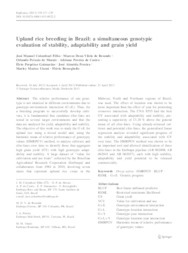Upland rice breeding in Brazil: a simultaneous genotypic evaluation of stability, adaptability and grain yield.
Upland rice breeding in Brazil: a simultaneous genotypic evaluation of stability, adaptability and grain yield.
Author(s): COLOMBARI FILHO, J. M.; RESENDE, M. D. V. de; MORAIS, O. P. de; CASTRO, A. P. de; GUIMARAES, E. P.; PEREIRA, J. A.; UTUMI, M. M.; BRESEGHELLO, F.
Summary: The relative performance of one genotype is not identical in different environments due to genotype-environment interaction (G9E). Thus, for a breeding program to successfully develop cultivars, it is fundamental that candidate elite-lines are tested in several target environments and that the data are analysed for yield, adaptability and stability. The objective of this work was to study the G9E for upland rice using a mixed model and, using the harmonic mean of relative performance of genotypic values (HMRPGV) method, to analyse cultivars and elite-lines over time to identify those that aggregate high grain yield (GY) with high genotypic adaptability and stability.
Publication year: 2013
Types of publication: Journal article
Unit: Embrapa Mid-North
Keywords: Arroz, BLUP, G x E, Genetic progress, Genética, HMRPGV, Melhoramento genético, Melhoramento genético vegetal, Oryza Sativa, REML
Observation
Some of Embrapa's publications are published as ePub files. To read them, use or download one of the following free software options to your computer or mobile device. Android: Google Play Books; IOS: iBooks; Windows and Linux: Calibre.
Access other publications
Access the Agricultural Research Database (BDPA) to consult Embrapa's full library collection and records.
Visit Embrapa Bookstore to purchase books and other publications sold by Embrapa.

